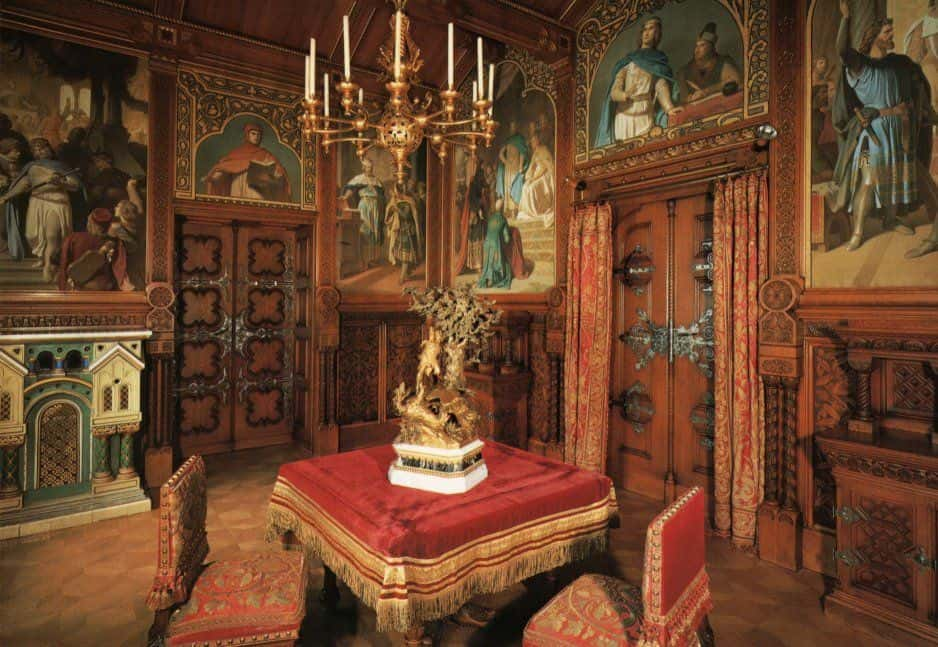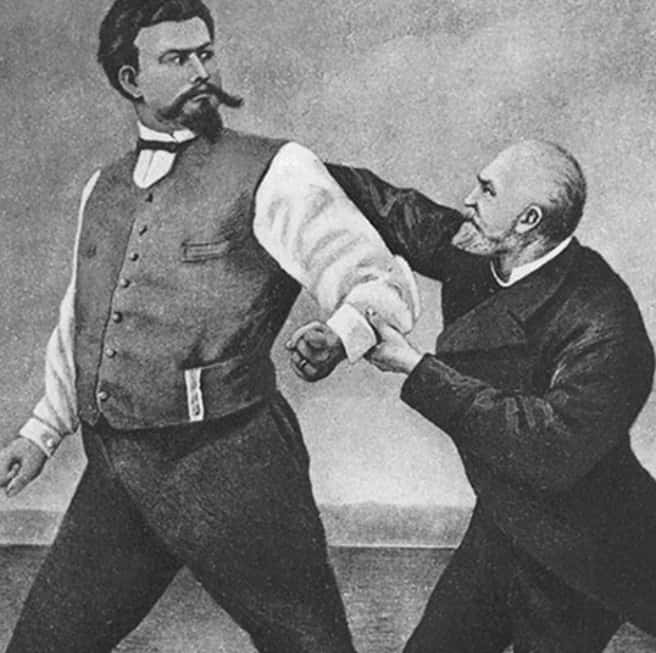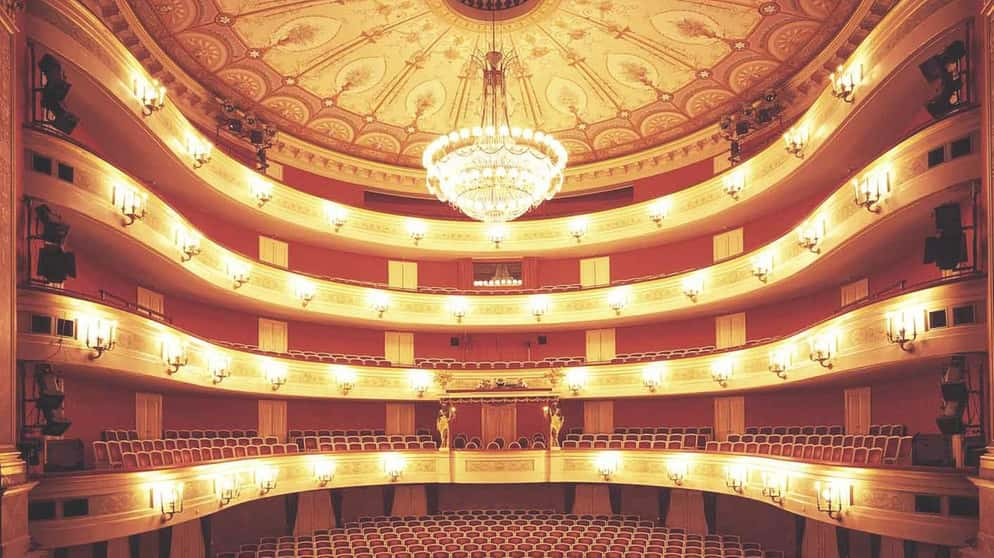Abendzeitung MünchenKing Ludwig II longed to rule over a fairytale kingdom. Instead, he ruled over a Bavaria which was becoming more modern and democratic. Ludwig all but abandoned his kingly duties in pursuit of a Romantic ideal and that pursuit cost him everything.
To some, he was the Mad King, whose obsessions nearly bankrupted the kingdom. To others, he was the Swan King, whose benevolence, charity, and imagination made Bavaria just a little more magical. How did Ludwig see himself? His only comment was, “I wish forever to remain an enigma, both to myself and others.”
Here are 42 grandiose facts about Bavaria’s Mad King.
42. The Birth of the King
Ludwig II was born, eldest son of Maximillian II of Bavaria and Princess Marie of Prussia on August 24, 1845. Ludwig’s birth certificate, however, reads August 25. Some suspect this was altered to further associate Ludwig II with his namesake, his grandfather and reigning King of Bavaria, Ludwig I.
41. Like Grandfather, Like Grandson
The plan worked, sort of. Ludwig II was particularly close to his famous grandfather. Like his grandson, Ludwig I was a passionate supporter of the arts, and spent as much time pursuing his own creative interests as he did the matters of the nation. And, less favorably, like his grandson, Ludwig I would also be chased from the throne.
40. Cool Parents
Ludwig II was less attached to his parents. His father, the king, although distant and detached, also saw to it that Ludwig had a strict, disciplined upbringing. He hoped, if nothing else, to mold young Ludwig into the ideal successor, a role Ludwig chaffed against. Ludwig summed up his relationship to both parents later in life, when he un-affectionately referred to his own mother as “my predecessor’s consort.”
39. This Old House
Ludwig was born into the House of Wittelsbach, a royal house that dated back as early as 980 AD, and included Holy Roman Emperors Louis IV and Charles VII. House Wittelsbach survives today under Franz, Duke of Bavaria.
38. Best Friends
Ludwig had a solitary childhood, but he did have one good friend at least, his cousin, Duchess Elizabeth of Bavaria. The two shared a love of nature, poetry, and riding, and referred to each other as “Eagle” and “Dove.” Elizabeth would go on to become Empress of Austria, before her murder at the hands of an anarchist in 1893.
37. A Star Is Born
When Ludwig was 15 years old, his father took him to a performance of Tannhäuser by Richard Wagner. Ludwig was enthralled. This introduction to the theater, and especially the works of Wagner, would have a profound effect on him for the rest of his life.
 Harvard Gazette - Harvard University
Harvard Gazette - Harvard University
36. Meeting of the Minds
Ludwig would later meet Wagner, spending nearly two hours with the great composer. The two hit it off, and would meet often after that, but Wagner worried for the young monarch, saying “Alas, he is so handsome and wise, soulful and lovely, that I fear that his life must melt away in this vulgar world like a fleeting dream of the gods.”
35. His Biggest Fan
Ludwig became Wagner’s greatest patron, giving the composer a kind of home base in Munich. However, the Münchners were scandalized by Wagner’s extravagant lifestyle and chased him out of town. Ludwig considered abdicating out of artistic principle, but Wagner talked him out of it.
34. Ludwig The Landlord
Ludwig continued to lend financial support to the exiled composer and even built him a house in Switzerland where he could stay until he was able to return to Munich.

History's most fascinating stories and darkest secrets, delivered to your inbox daily.
33. The Hipster King
For the rest of his life, Ludwig would be a committed patron of the arts. In addition to his support of Wagner, he would be instrumental in bringing the works of Shakespeare, Ibsen, and Mozart to Munich for the first time.
32. The Freshman
Maximillian II died in 1864, leaving Ludwig II in control of Bavaria. Ludwig was only 18 years old and had little interest in matters of politics or statecraft. His first order of business was to establish a new Court Theater.
 Pinterest
Pinterest
31. The Show Must Go On
That theater, by the way, is still going strong. As one of the most active theatres in Germany, the Staatstheatre am Gärtnerplatz continues to host more than 200 opera, ballet, and musical theater performances every year.
30. Entitled
In addition to serving as King of Bavaria, Ludwig II also held the titles Count Palatine of the Rhine, Duke of Bavaria, Duke of Franconia, and Duke of Swabia. These were essentially ceremonial titles dating back the Holy Roman Empire, and most of the regions they referred to had been incorporated into Bavaria by the time Ludwig succeeded to the throne.
28. A King Without a Kingdom
Four years later, Prussia entered into the Franco-Prussian War. Obligated to support Prussia, Bavaria essentially ceded its status as an independent kingdom, becoming part of the North German Confederacy.
27. His Own Independence Day
Though Ludwig was obliged to publicly support the idea, he refused to attend the unification ceremony, sending his brother and uncle in his place.
26. The Traveling Stranger
The loss of Bavaria’s independence could only be considered a kingly failure, but Ludwig’s popularity never wavered. He was broodingly handsome and frequently rode the countryside in disguise, giving gifts and large sums of money to the kindlier and more hospitable farmers he met along the way. To the Bavarians, Ludwig was the ideal romantic hero.
 iCollector
iCollector
25. Break-ups Are Hard
In 1867, Ludwig became engaged to his cousin, Duchess Sophia of Bavaria. Sophia was the sister of his beloved friend, Elizabeth. After several postponements, the engagement was finally broken off in October of that year. While no reason was ever announced, Ludwig claimed in a letter to Sophia, “your cruel father has torn us apart!”
 Pinterest
Pinterest
24. Shared Interests
Ludwig did admit, in one letter to Sophia, that the only thing they really had in common was a mutual love of Wagner.
 "L
"L
23. Short Stay
Despite the years and years of planning and labor, not to mention the incredible personal debt he accumulated, Ludwig only spent 11 nights in his beloved Neuschwanstein Castle.
22. Not My Job
Ludwig, solitary and creative by nature, refused to hold state banquets or attend military functions after 1876.
21. Obsession
Ludwig’s enduring legacy is his building projects, though they were mostly for his own enjoyment. In addition to the opera house and mansion he built specifically for Wagner, Ludwig built, or had begun construction on, five castles or palaces.
20. Game of Thrones
King Ludwig’s obsession with building huge, elaborate castles continues to make him famous. In 2014, Bezier Games released a board game that celebrates Ludwig’s castle compulsion. Castles of Mad King Ludwig challenges players to build the most over-the-top castles and palaces from a set collection of “room tiles.” One to four players, ages 13 and up.
 YouTube
YouTube
19. Lesser Palaces
Some of Ludwig’s building projects were relatively small, but they were still incredibly elaborate and ornate. Herrenchiemsee, built on an island in Bavaria’s Chiemsee Lake, was meant to be an exact replica (though smaller) of the Palace of Versailles.
His royal apartment in Munich, the Munich Residenz, featured a private garden, and what could only be described as set-pieces from around the world: backdrops of the Himalayan mountains, Indian fishing huts out of bamboo, and a “Moorish kiosk” filled with artifacts from Northern Africa.
18. A Private Versailles
Of Ludwig’s three major castles, Linderhof was the smallest and the only one he lived to see completed. Based, modestly, on the Palace of Versailles, it cost more than 8 million marks and was completed in 1866.
17. The Unfinished Masterpiece
At the time of Ludwig’s death, he and Jank were just beginning construction on a new castle, Falkenstein. Done in dramatic, gothic style, and at an elevation of more than 4,000 feet, it would have surpassed Neuschwanstein in every way. The architects took the opportunity to go as elaborate and impractical as they wished with their plans, already knowing the castle would never be built.
16. Matching Sets
Aesthetically, Ludwig was all over the map. His buildings featured elements of Rococo design, exoticism, Neo-classicism, Gothicism, and even some early Modernist touches. Because traditional architects had a hard time keeping up with Ludwig’s impulsive, imaginative ideas, he preferred to leave the design work of his castles up stage and set designers, most notably Christian Jank, who had previously worked with Wagner.
15. King Of The Castles
Jank was the lead designer on what was to be Ludwig II’s crowning achievement, Neuschwanstein Castle. Sitting at an elevation of more than 2,000 feet on a hill overlooking the village of Hohenschwangau, Neuschwanstein notably provided the inspiration for Sleeping Beauty’s castle at Disneyland. Construction of Neuschwanstein began in 1868 and was not completed by the time of Ludwig’s death in 1886.
14. Job Creator
Neuschwanstein could be remembered as a debacle, an exercise in opulence and megalomania which bankrupted its creator. But it’s worth remembering the construction of Neuschwanstein created steady work for Bavarian builders for nearly 20 years. At one point, as many as 300 workers worked on the building; it took 14 carpenters four solid years of hard work to finish the woodwork in Ludwig’s bedroom! Not only were these workers insured, they also received a pension.
13. Materials
Though it had room for neither a throne room or a royal court (making it unsuitable for any kind of royal government work) Neuschwanstein covers an estimated 65,000 square feet. A single year’s inventory of building materials included 465 tons of marble, 1,550 tons of sandstone, and just shy of half a million bricks. Scaffolding alone required 2,680 cubic yards of wood.
12. All Mod Cons
While Ludwig was obsessed with romantic, historical ideas, his castles—and Neuschwanstein especially—were state of the art buildings for their time. Neuschwanstein had power generators, electric lights, running water, flush toilets, and telephone lines. There was even an automated lift in the dining room that, at the touch of a button, raised or lowered the dining table to the room below so that Ludwig would not have to watch his servants set the table.
 Pinterest
Pinterest
11. Take Only Memories
Neuschwanstein Castle receives as many as 6,000 visitors a day. Each year, 1.3 million people from far and wide come to marvel at King Ludwig’s imagination and opulence. But unless you go there yourself, the interiors of Neuschwanstein will largely have to remain a mystery: photography is not permitted inside the castle.
10. Bankrupt!
At the time of his death, Neuschwanstein Castle had cost Ludwig more than 6.5 million marks, more than double the original budget. Had the king lived, that cost would almost certainly have been significantly higher.
Ludwig paid for Neuschwanstein, as well as his other projects, with his own private income, but as the costs escalated, he began to seek out loans. He even sought a loan from the Bavarian government, which declined the request. Ludwig’s personal debt reached more than 14 million marks, enough that his creditors sought to seize possession of his castle. In response, Ludwig threatened to kill himself.
9. The Plot
With Ludwig ignoring not only his own impossible financial situation but also all matters in state to devote himself full-time to his building projects, his ministers began taking steps to remove him from the throne. Not only was he ill-suited to the role of king, they argued, but his mental health was becoming a worry.
Ludwig’s uncle, Luitpolt, recognizing their concern, agreed to take over as king if it could be proven that Ludwig was mentally unfit.
8. By Unanimous Decision
The ministers assembled a team of psychiatric assessors led by Dr. Bernhard Von Gudden who quickly ascertained that Ludwig was mentally unsound.
Though they never spoke with Ludwig personally, they compiled a list of observations which confirmed the king’s mental state. The list included his habit of wearing a coat in summer, but eating outdoors in winter, his rough manner with his servants, and, obviously, his exorbitant and reckless spending.
7. The Siege
With Ludwig declared mad, the ministers were free to depose him and sent a commission to arrest Ludwig and place him in the custody of Dr. Von Gudden. Ludwig holed up in Neuschwanstein with a private army for two days while 36 armed guards surrounded the castle. He was finally caught trying to escape. When arrested, he said to Von Gudden, “How dare you declare me insane? You’ve never examined me before!” Insane or not, Ludwig had a point.
6. Whodunit
Von Gudden took Ludwig to rest at Berg Castle just south of Munich. On the evening of June 13, 1886, the two men took a walk together along the shore of Lake Starnberg. No one knows what happened next. The bodies of Ludwig and Von Gudden were found that night floating in the lake.
Neither had water in their lungs, but Von Gudden’s body showed signs of strangulation and bludgeoning. The mystery has never been solved, though modern historians suggest that Ludwig and his doctor may have been murdered by Ludwig's enemies while he was attempting once more to escape.
 Munich et la Bavière, Louis II et Richard Wagner
Munich et la Bavière, Louis II et Richard Wagner
4. The King's Closet
Ludwig never did marry and had no known mistresses. Close friendships with a number of men, especially with his chief equerry, led many to suspect that Ludwig was gay. Ludwig’s private diaries strongly suggest that Ludwig was indeed a homosexual, and struggled to reconcile his sexual orientation with his devout Catholicism.
3. French Kiss
At Linderhof, visitors could see the signs of Ludwig’s eccentricity turning into full-blown madness. He had a large statue of Marie Antoinette in the front hall whose cheek he would caress and kiss as he passed; servants often heard him from the other room, speaking with the statue. Soon he began insisting extra places be set at his table, to make room for the dead French monarchs, and insisting that he was the heir to France through Louis XVI.
2. The Mad King?
In 2014, a team of German psychiatrists led by Dr. Heinz Hafner pored through the surviving documents of Ludwig’s case and came to a shocking decision: the Mad King wasn’t mad at all! Dr. Von Gudden and his associates were unable—or unwilling—to make a reliable assessment of the king’s mental health.
1. Happy Ending?
According to Hafner, Von Gudden’s initial investigation was severely biased against the king. Not only had Von Gudden not personally met Ludwig in more than a decade, but witnesses Von Gudden spoke with were strongly biased against the king. Those sure don’t sound like reasonable grounds for judging someone’s sanity.
But to be fair, Dr. Hafner never met King Ludwig either, and verified autopsy reports confirm that Ludwig’s brain had some degeneration in the frontal and temporal lobes, consistent with dementia. It seems Ludwig will get his wish, to die as an enigma.
Sources: 1, 2, 3, 4, 5, 6, 7, 8, 9, 10, 11, 12, 13, 14, 15, 16












































